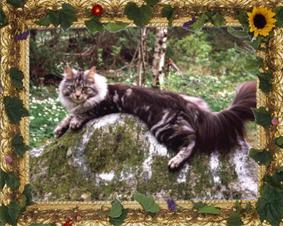

 |
 |
|
History
of a Norwegian Forest cat begins from the depth of ages. We know it from
the first descriptions of these cats we meet as far back as ancient fairy
tales, which were being sent by word of mouth. The first written evidence
has appeared in a child's book in 1912, then we could meet it in autobiography
of an artist Olaf Galbransson, where he used this breed representative's
drawing made as far back as 1910. |
|
 FodnaheiaТs Hedda Unni R. Iversen, av Sandrabben, Norway |
|||
 EC S* Tassajara's Christa |
|
|||
|
The
Norwegian forest cats recognized as wild but useful animals have got official
protection. In Norwegian forest reserves forest-guards had responsibility
for these local fauna representatives and were to trace and stop poachers
who caught and took these cats from the country.
|
||||
|
 Gr IntCh SilverwoodТs Dark Disney Design Jane Christensen, УSilverwoodФ, Denmark |
|
||
|
One
year later in Norway this breed was acknowledged and a unified standard
was accepted. Cats got experimental pedigrees and there were about 100
registered animals in Norway in 1976. This year annual FIFE meeting was
held in Vesbaden (Germany) where the breed of "Norwegian forest cat"
was recognized as experimental and this breed began to spread all round
the world. The first couple was sold into Sweden and on the 29th of November,
1979 the first representatives of this breed arrived in USA. Sheila Gir
bought Pans Tigris (male, brown tabby, the breeder of Else Nylund) and
Mjavo's Sala Palmer (female, black with white, the breeder of Solveig
Stenersroad) for the nursery of Maincoon (Michigan, USA). These cats were
registered in the Department of trading of Norway as export goods. All
this time Norwegian phelinologists have been working with this breed.
And when in Paris in 1977 a meeting of FIFE took place, Frederick Nordan
(president of NRR) and other Norwegian phefinologists demonstrated to
the presents a great number of photo materials and pedigrees with three
generations in them. This time they have achieved a success
and the breed of Norwegian forest cat was officially recognized. Litter
class (i.e. cats non-registered in NRR and not having a complete
pedigree) was closed except Finland where litter class was open up to
1992.
All Norwegian forest cats registered in NRR had been descended from wild cats inhabited in woods of Norway and they were not subject to export beyond the bound of the country. Nowadays
this breed is one of the most popular in Scandinavia and spreads all over
the world. On cats exhibitions it always causes delight and interest and
it is predicted the greater future.
Norwegian forest cats are clever animals and very attached to a house. But still there is something wild in their vigilant, watchful and all-seeing glance; triangular head with the direct profile; graceful ears with long lynx-like tufts - a typical inhabitant of wild impenetrable woods; a lissome and brawny body ready meet any danger; graceful strong legs that enable these cats to move fast and climb up on the top of the highest tree with lightning speed; feathery tail, triumphally waving over everything. |
||||
|
 Int Ch Bjork av Borgund Unni R. Iversen, av Sandrabben, Norway |
|||
|
|
||||
 Pandora Bjarn Arvesen, Stavanger, Norway |
Young
skogkatts like to play very much but only if they want. Besides they like
to be caressed, they need your attention; they dislike a long solitude,
but herewith they stay independent.
Inhabitants of Norway are proud of their national cat breed. Many breeders can tell us about their cats for hours, they impart any information and show pictures with great pleasure. They would like people in Russia to get to know, like and appreciate these wonderful cats at its true value. |
|||
|
яндекс реклама: |
|
|